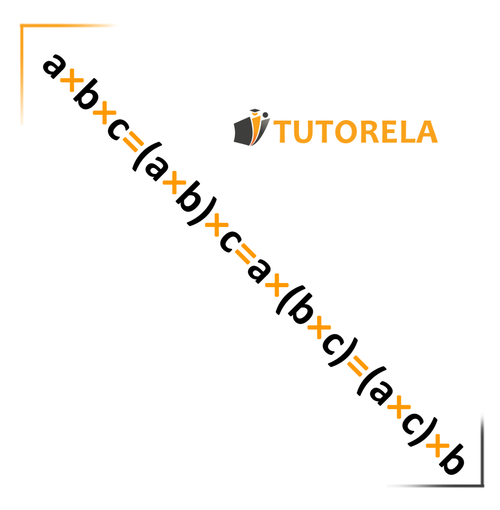Let's see an example:
X×5×3=X×15
We associate the second and third factors, multiply them, then multiply the product by the first factor.
We will get an expression equivalent to the first expression, since the associative property does not change the result.
Let's put a number in place of X to verify:
X=2
2×5×3=2×15
30=30
As we can see, after applying the associative property and multiplying the last two terms (the second and third factors), and then multiplying the product by the first term, the result is the same.
Let's take a look at the following examples:
4×5×2
It will be easier for us to solve the exercise if we first solve 5×2 and only then multiply the result by 4.
The associative property of multiplication allows us to do just that. We will get:
4×5×2=4×10=40
Let's look at another example:
9×25×4
It will be easier for us to solve the exercise if we first solve 25×4 and only then multiply the result by 9.
The associative property of multiplication allows us to do just that. Giving us:
9×25×4=9×100=900
Practice this property over and over until it becomes second nature. It will come in hand down the road for many of the different types of mathematical exercises you will encounter.
Task:
7×5×2=
Solution:
7×5×2=7×10=70
Answer:
70
Task:
3×5×5=
Solution:
3×5×5=3×25=75
Answer:
75
Task:
35×6×2=
Solution:
35×6×2=
(30+5)×6×2=
=180+30×2
=210×2
=420
Answer:
420
Task:
(8−3−1)×4×3=
Solution:
(8−3−1)×4×3=?
(5−1)×4×3=?
(5−1)×4×3=4×4×3
=16×3=48
Answer:
48
Task:
(7−4−3)(15−6−2)+(3×5×2)=?
Solution:
(7−4−3)(15−6−2)+(3×5×2)
(3−3)(9−2)+(3×10)
0×7+30=0+30=30
Answer:
30
Task:
4.1×1.6×3.2+4.7=?
Solution:
4.1×1.6×3.2+4.7=?
=4101×1106×3102=4107
1041×1016×1032+1047=100656×1032+1047
10×1041×16=100656
=100×10656×32+1047=
=100020992+10004700
=100025692=25.692
Answer:
25.692
Task:
74×23×47=?
Solution:
We start by associating the left side of the expression:
74×23=7×24×3=1412=76
We continue with the whole expression:
74×23×47=76×47=46=23=1.5
Answer:
23
What is the associative property in multiplication?
The associative property of multiplication tells us that in a multiplication expression with three or more factors, we can multiply factors out of order without changing the result.
For example, one way to solve the following
6×3×5=
is to associate the first two factors first
18×5=90
Or we can associate the second two factors first and the result is multiplied by the first factor.
6×3×5=
6×15=90
As we can see, in both cases we will get the same answer.
How is the associative property used with addition and multiplication?
In addition
The associative property in addition is represented as follows: a+(b+c)=(a+b)+c=(a+c)+b
This means that no matter how we order the addends, the result is the same.
Let's assign values to a=3, b=8 and c=15
Then, applying the associative property, we will have:
3+(8+15)=3+23=26
(3+8)+15=11+15=26
(3+15)+8=18+8=26
We get the same answer in all three cases.
In multiplication
The associative property in multiplication can be represented as follows: a×(b×c)=(a×b)×c=(a×c)×b
This means that no matter which numbers are multiplied first the result is the same.
Let's assign values to a=7, b=3 and c=2
Then, applying the associative property, we will get:
(7×3)×2=21×2=42
7×(3×2)=7×6=42
(7×2)×3=14×3=42
We can see that all three expressions gave us the same answer, even though the factors were in a different order.
What are the associative, commutative and distributive properties of multiplication?
Associative: We can regroup the factors of an expression without changing the result.a×(b×c)=(a×b)×c=(a×c)×b
Commutative: We can reorder the factors in an expression without changing the result.
a×b=b×a
Distributive: We can break down a multiplication operation into simpler expressions. a×(b+c)=a×b+a×c










